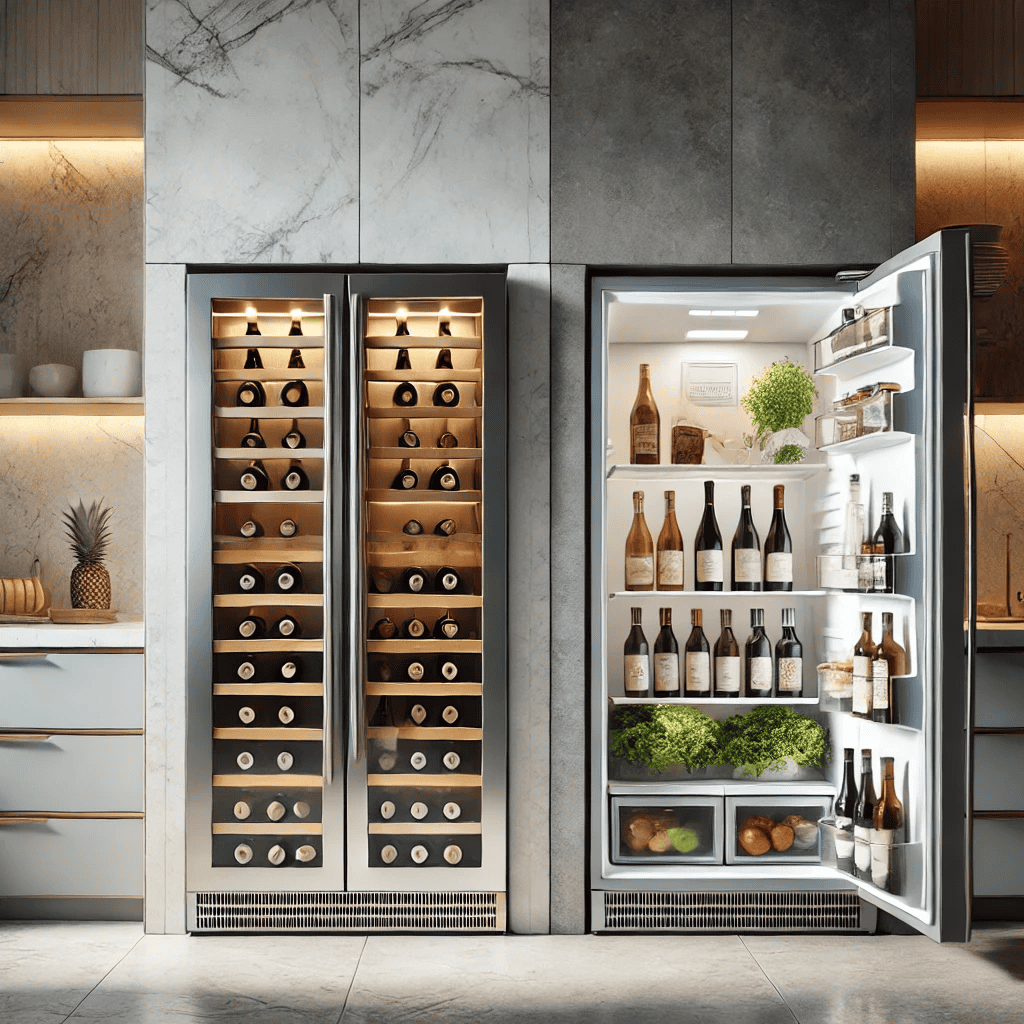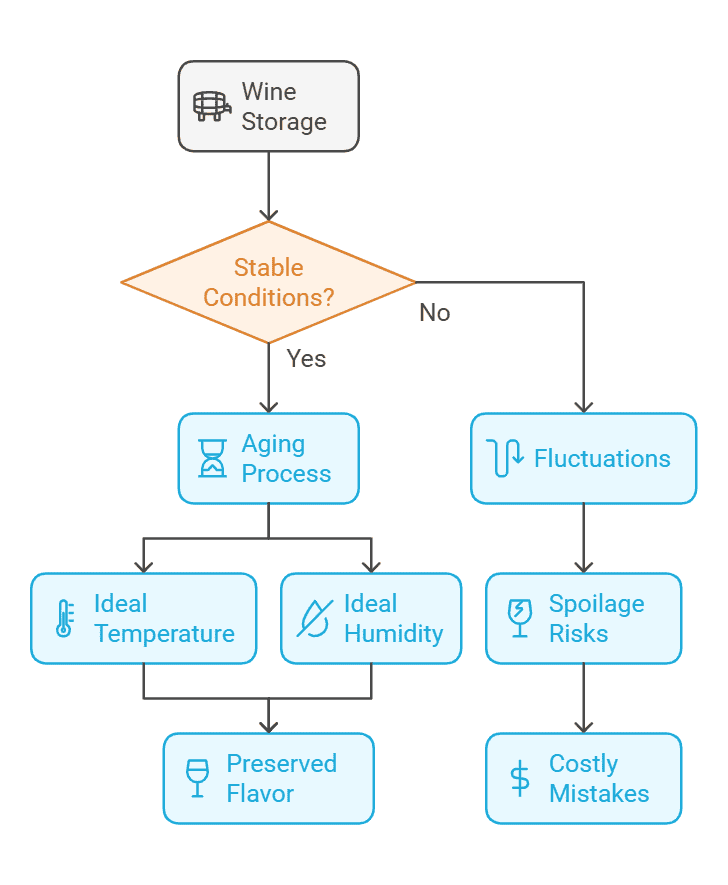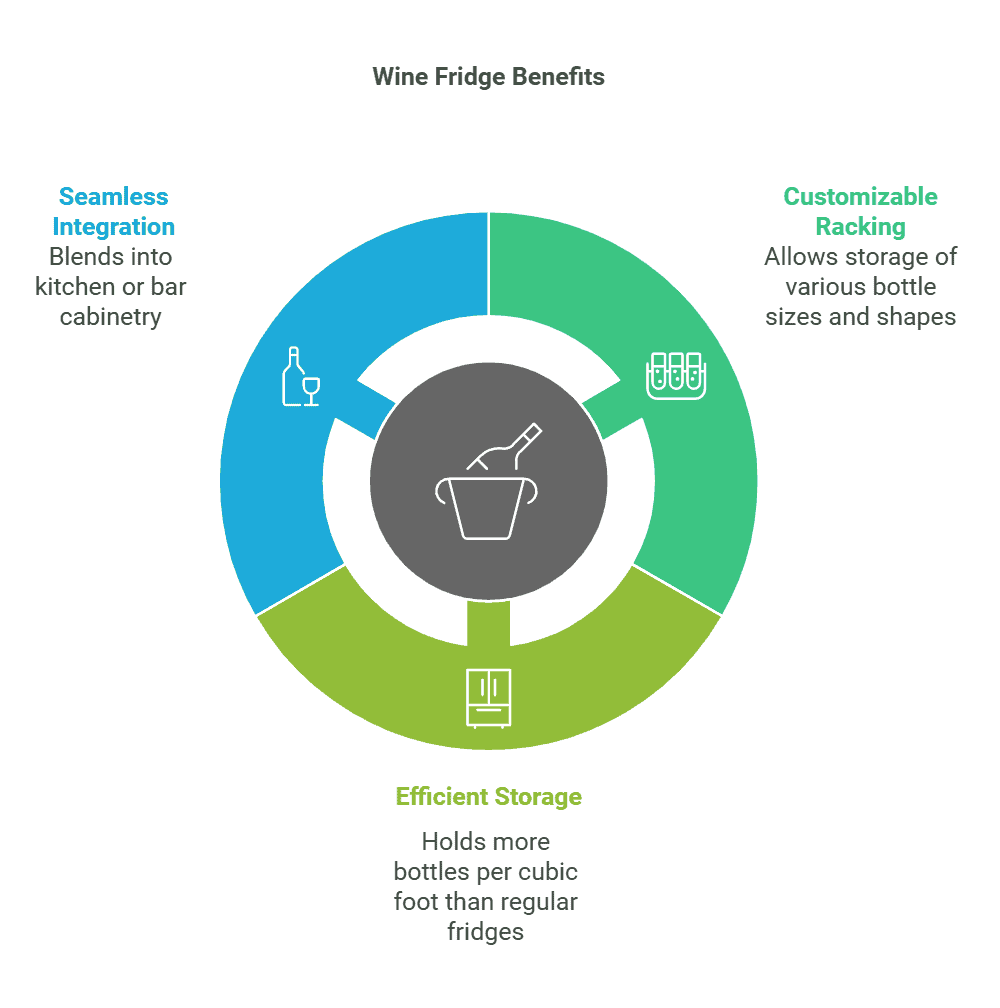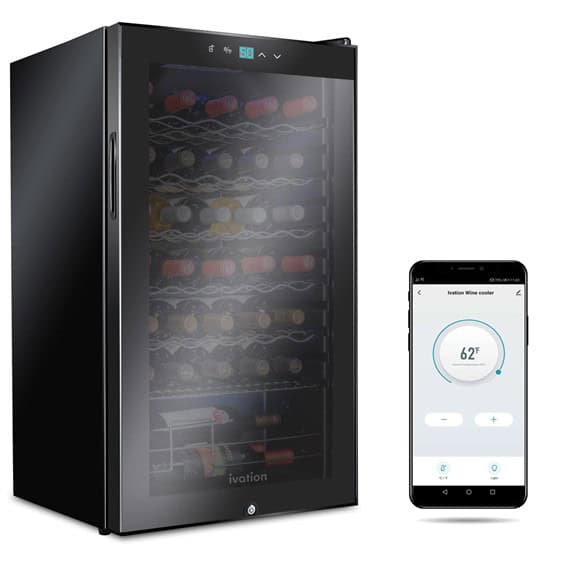Did you know that storing wine at the wrong temperature can drastically alter its taste and aging potential?
According to a study by the International Wine and Spirits Research, improper wine storage leads to approximately 20% of wine spoilage worldwide!
As wine enthusiasts, we often face the dilemma of choosing between a dedicated wine fridge vs regular refrigerator. In this article, I’ll guide you through the crucial differences between these storage options and help you make a suitable decision to protect your valuable wine collection.
Welcome to Didi Somm and Cheers!
Important Notice: The information in this article is for general and public information purposes only. It solely reflects Didi Somm’s or his Staff’s opinion, and no responsibility can be assumed for errors or omissions in the service’s contents. For details, please check the Disclaimer at the bottom of the homepage.

Key Takeaways
- Wine fridges maintain optimal temperature and humidity levels specifically for wine storage
- Regular refrigerators are too cold and dry for proper wine preservation
- Wine fridges offer specialized features like UV protection and vibration control
- Investing in proper wine storage can significantly extend the life of your wine collection
- Different wine varieties require different storage temperatures
Understanding Wine Storage Fundamentals
Let me tell you something I learned the hard way about wine storage – it’s not just about keeping bottles cold!
After watching a $200 bottle of Bordeaux turn into expensive vinegar, I dove deep into the science of wine preservation. Wine storage is actually quite fascinating, involving a delicate balance of temperature, humidity, and environmental factors.
The most critical element is maintaining stable conditions; even small fluctuations can trigger chemical reactions that affect the wine’s flavor profile. Think of your wine as a living thing that’s constantly evolving.
The ideal storage temperature sits between 55-59°F (13-15°C), creating the perfect environment for slow, graceful aging. Humidity plays an equally crucial role, ideally hovering between 60-70% to keep corks from drying out. I’ve seen countless corks shrink and let oxygen seep in, leading to premature aging and spoilage.
When it comes to aging, it’s all about creating a stable environment that allows the complex chemical reactions in the wine to proceed at just the right pace. Trust me, understanding these fundamentals will save you from some costly wine storage mistakes I’ve made over the years.

Temperature Control: Wine Fridge vs Regular Refrigerator
Here’s a truth bomb about regular fridges – they’re absolutely terrible for storing wine!
I learned this after keeping some nice bottles in my kitchen fridge for “just a few weeks” (spoiler alert: bad idea). Your standard refrigerator typically runs at around 40°F (4°C), which is way too cold for wine storage and can actually dull the flavors.
Plus, these fridges experience frequent temperature fluctuations every time you open the door. Think about it: you’re probably opening your kitchen fridge dozens of times a day! In contrast, a proper wine fridge maintains a consistent temperature between 45-65°F (7-18°C), with different optimal ranges for various wine types.
Below is a brief comparison of the most important features:
Wine Fridge vs. Regular Fridge: Temperature & Usage Comparison
| Feature | Wine Fridge | Regular Fridge |
|---|---|---|
| Temperature Range | 45°F to 65°F (7°C to 18°C) | Around 40°F (4°C) |
| Temperature Stability | Consistent, minimal fluctuations | Fluctuates due to frequent opening/closing |
| Humidity Control | Maintains ideal humidity (50%-70%) | The humidity is low; it can dry out corks |
| Purpose | Specifically designed for wine storage | Designed for food preservation |
| Capacity | Shelves optimized for wine bottles | Not optimized for wine bottles |
| Vibration Levels | Minimal vibration to protect wine aging | Compressor vibrations can disrupt aging process |
Summary of Facts:
- Wine Fridges: Ideal for proper wine aging and serving conditions, maintaining stable temperatures and humidity levels. Perfect for wine enthusiasts and collectors.
- Regular Fridges: Too cold and dry for long-term wine storage. Suitable for short-term storage of non-vintage wines.
- Red Wines generally prefer slightly warmer temperatures around 60-65°F (15-18°C), while White Wines are happier at 55-60°F (13-15°C).
- Temperature Stability: Wine fridges are designed to minimize temperature swings, maintaining a steady environment that protects your wine’s integrity.
- Energy Efficiency: Wine fridges actually consume less power since they operate at higher temperatures and don’t need to work as hard to recover from frequent door openings.
Humidity Management
Managing humidity might seem like a minor detail, but let me tell you – it’s make-or-break for long-term wine storage.
I once lost several bottles to dried-out corks, and it was a wake-up call about humidity’s importance. Regular refrigerators are moisture-sucking machines, typically maintaining humidity levels around 30% or lower. This is precisely why your vegetables need a crisper drawer!
For wine, this dry environment is disastrous. Wine fridges, on the other hand, are specifically designed to maintain optimal humidity levels between 60-70%. This sweet spot keeps corks moist and properly expanded, maintaining their all-important seal. Too little humidity causes corks to shrink and allow oxygen to seep in, while too much can promote mold growth and damage labels.
Most quality wine fridges feature built-in humidity control systems or reservoirs that maintain ideal moisture levels automatically. I’ve found that monitoring humidity with a simple hygrometer can prevent costly storage mistakes and ensure your wine ages gracefully.
Special Features of Wine Fridges
The special features in wine fridges might seem like fancy bells and whistles, but they’re actually game-changers for proper wine storage.
UV Protection
I remember being skeptical about spending extra for UV protection until I saw how quickly sunlight affected some bottles in my old storage setup. Modern wine fridges come with UV-resistant glass doors that protect your wine from harmful light exposure, which can cause premature aging and off-flavors.
Anti-Vibration Technology
Anti-vibration technology is another feature I’ve grown to appreciate – it prevents subtle disturbances that can interfere with the aging process and sediment settlement. Most quality units offer dual or even triple temperature zones, allowing you to store different wine types at optimal temperatures.
Racking Systems
I particularly love the specialized racking systems that cradle bottles at the perfect angle, keeping corks moist and accommodating various bottle sizes. Pro Tip: To see the latest wine racking systems in the market, I highly recommend visiting the Wine Racks America website.
Digital Monitoring Systems
The digital temperature control and monitoring systems provide peace of mind, allowing you to track storage conditions precisely and adjust as needed.
Affiliate Disclaimer: This page may include Affiliate links, meaning that we get a commission if you decide to purchase through this site at no extra cost to you. Please read our Disclaimer for your info.
Cost Analysis and Investment Considerations
Let’s talk money – because investing in proper wine storage is all about the long game.
When I first started collecting wine, I balked at the price of a quality wine fridge, thinking my regular refrigerator would do just fine. Big mistake! Initial costs for a decent wine fridge typically range from $200 to $2,000, depending on size and features. However, the long-term value becomes clear when you consider that improper storage can ruin wines worth many times that amount.
Energy-wise, wine fridges are surprisingly efficient, consuming about 100-200 watts on average – similar to a standard light bulb. Maintenance costs are relatively low, mainly involving periodic cleaning and occasional filter replacement.
ROI – My Conclusion
I’ve found that the Return On Investment becomes obvious when you consider that properly stored wines can appreciate in value over time, not to mention the money saved from preventing spoilage. Additionally, factor in the extended lifespan of your collection, and a quality wine fridge practically pays for itself.
Space Utilization and Storage Capacity
Getting the most out of your wine storage space is crucial, and I’ve learned some valuable lessons about maximizing capacity without compromising accessibility.
The key is finding the right balance between storage density and easy access to your bottles. Most wine fridges offer customizable racking systems that can accommodate different bottle sizes and shapes – something I really appreciate since not all wine bottles follow the standard Bordeaux format.
When comparing space requirements, a dedicated wine fridge actually offers more efficient bottle storage per cubic foot than a regular refrigerator, thanks to specialized racking designs. I’ve found that a 24-inch wide wine fridge typically stores 40-50 bottles in the same space, whereas a regular fridge might awkwardly fit 15-20 bottles.
The ability to integrate wine fridges into your existing cabinetry is another huge plus – some of my favorite installations have been built-in units that blend seamlessly with the kitchen or home bar design while maximizing storage efficiency.

FAQ – Wine Fridge vs Regular Refrigerator
- Can I store wine in my regular kitchen refrigerator long-term? No, regular refrigerators are too cold and dry for long-term wine storage, potentially damaging the wine’s quality.
- What is the ideal temperature for storing red wine? The ideal temperature range for red wine storage is between 55-65°F (13-18°C).
- How much does a quality wine fridge cost? Quality wine fridges typically range from $200-$2000, depending on size and features.
- Do wine fridges consume more energy than regular refrigerators? No, wine fridges generally consume less energy as they operate at higher temperatures and open less frequently.
- How many bottles can a standard wine fridge hold? Standard wine fridges range from 12 to 300+ bottles, with popular sizes holding 30-50 bottles.
- Should I get a single-zone or dual-zone wine fridge? Choose dual-zone if you store both red and white wines, as they require different storage temperatures.
- How long do wine fridges typically last? A quality wine fridge can last 10-15 years with proper maintenance.
- Can I store other beverages in my wine fridge? Yes, but it’s recommended to dedicate the space to wine to maintain optimal conditions.
- What humidity level should I maintain in my wine fridge? The ideal humidity level for wine storage is between 60-70%.
- How often should I clean my wine fridge? Clean your wine fridge every 3-6 months to maintain optimal performance.
- Can wine fridges be built into cabinetry? Yes, many models are designed for built-in installation with proper ventilation.
- Do I need a wine fridge if I don’t collect expensive wines? While not essential, a wine fridge helps preserve the quality of any wine you plan to store for longer than a few weeks.
- What’s the minimum distance between wine bottles in storage? Bottles should have at least 1/4 inch space between them for proper air circulation.
- How do I prevent vibration damage to my wines? Choose a wine fridge with anti-vibration features and place it away from appliances.
- Can I store opened wine bottles in a wine fridge? Yes, but consume opened bottles within 3-5 days for best quality.
Conclusion
While regular refrigerators serve their purpose for short-term wine storage, a dedicated wine fridge is essential for maintaining optimal wine preservation conditions.
Investing in a proper wine storage solution pays off through better-preserved wines and enhanced drinking experiences. Whether you’re a casual enthusiast or a serious collector, I hope you have gained some useful information to help you choose the suitable wine refrigerator for your precious wine collection.
Good luck, enjoy, and Cheers!
For your reference, the latest articles by Didi Somm include:
- Wine Cellar Lighting Options: Latest Insights And Best Guide
- Commercial Wine Racking Systems: All You Need To Know
- Top Commercial Wine Inventory Management Software: All You Need To Know
- Wine Storage Vibration Control: Best Advice For Commercial Storage
- The Ultimate Wine Refrigerator Guide: Best Expert Tips For You
- How To Choose The Perfect Wine Fridge: A Beginner’s Guide 2025
Important Notice: The information in this article is for general and public information purposes only. It solely reflects Didi Somm’s or his Staff’s opinion, and no responsibility can be assumed for errors or omissions in the service’s contents. For details, please check the Disclaimer at the bottom of the homepage.





